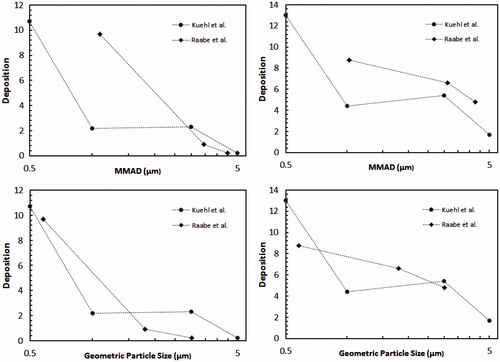Kuehl et al. (Citation2012) recently produced an excellent paper on regional polydisperse aerosol deposition in rats and mice, comparing their results with earlier work by Raabe et al. (Citation1988). Kuehl et al. (Citation2012) concluded that the differences between the results were most likely because the Raabe et al. (Citation1988) study used monodisperse particles, while the former used polydisperse particles (possible differences in breathing rates and differing mouse strains were also suggested). However, the particle densities used in both studies differed significantly. Raabe et al. (Citation1988) used silica particles and reported a density (ρp) of 2460 kgm−3, however most literature gives a higher density of ∼2700 kgm−3. Furthermore the particles were labelled with 169Yb, with a reported density of 7000 kgm−3. Kuehl et al. (Citation2012) do not report the density of the particles they used, however given that they were generated from a colloidal sulphur in a weak saline solution and apparently not explicitly dried using a diffusion dryer or similar, it is reasonable to assume that their particles have an effective bulk density of ∼1000 kgm−3. This assumption is supported by our simulated deposition study (Mead-Hunter et al., Citation2013) which produced results which agreed well with Kuehl et al.’s (Citation2012) results, using either 0.5-µm polydisperse or monodisperse particles with ρp = 1000 kgm−3. Therefore, in addition to the fact that one particle type was a (dry) solid and one a liquid colloid, a significant physical size difference exists between the particles used in the Raabe et al. (Citation1988) and Kuehl et al. (Citation2012) studies.
Particle capture by inertial mechanisms can be assumed to be dependent on mass mean aerodynamic diameter (MMAD), or more precisely on Stokes’ number (Stk). For equivalent flow velocities and deposition surface geometries, we can simplify stokes number to be proportional to,
where dp is the particle (geometric) diameter and Cc the Cunningham correction factor, which is also a function of dp. Therefore, we can use Equation (1) to calculate the physical diameters of the particles used for each study. gives these diameters. It should also be noted that Kuehl et al. (Citation2012) did not report the correct diameter for the particles used by Raabe et al. (Citation1988), and the correct diameters are given in . The geometric diameters given below agree with the images shown in of Raabe et al. (Citation1988).
Figure 1. Graphical representation of interception effect (left) and the combined interception-diffusion effect (right). In both cases, the larger (less dense) particle is collected as it contacts the wall, whereas the smaller particle is not. This is despite the two particles possessing the same aerodynamic diameter.

Table 1. Reported aerodynamic diameters used by Kuehl et al. and Raabe et al. and geometric diameters for both studies.
However, particle capture in the respiratory system (especially in the lung) cannot be assumed to occur purely by inertial mechanisms. Interception mechanisms (and the interaction between interception and diffusion) are also important in the size ranges and flow velocities we are concerned with. Interception is proportional to physical particle diameter, rather than aerodynamic diameter (Hinds, Citation1999). shows the importance of the differing particle diameters used by the two studies on collection by interception, it can be seen that the smaller (Raabe) particles can pass by without being collected, whereas the larger (Kuehl) particles are intercepted, despite both particles travelling on the same streamline.
Furthermore, if we plot the deposition measured in both studies as a function of physical diameter (, lower panels), it can be seen that we achieve better overall agreement than by comparing MMAD sizes (upper panels in ). The geometric size agreement is best for the smaller particles, and MMAD agreement better for larger particles, suggesting that collection due to interception becomes more important for smaller particle sizes.
Figure 2. Geometric and MMA diameter plots of pulmonary deposition for both studies. The left panels are mouse data and right panels rat data.

In conclusion, we do not intend for this comment to detract from the quality of the work undertaken by Kuehl et al. (Citation2012), but rather to highlight the significance of particle interception, and therefore the importance of reporting particle density and geometric size.
Supplementary Material
Download PDF (1.4 MB)Supplementary Material
Download PDF (1.4 MB)Supplementary Material
Download PDF (1.4 MB)Supplementary Material
Download PDF (1.4 MB)References
- Hinds WC. (1999). Aerosol technology: properties, behaviour, and measurement of airborne particles. New York, NY: John Wiley and Sons
- Kuehl PJ, Anderson TL, Candelaria G, et al. (2012). Regional particle size dependent deposition of inhaled aerosols in rats and mice. Inhal Toxicol 24:27–35
- Mead-Hunter R, King AJC, Larcombe AN, Mullins BJ. (2013). The influence of moving walls on respiratory aerosol deposition modelling. J Aerosol Sci 64:48–59
- Raabe OG, Al-Bayati MA, Teague SV, Rasolt A. (1988). Regional deposition of inhaled monodisperse coarse and fine aerosol particles in small laboratory animals. Ann Occupat Hygiene 32:53–63
